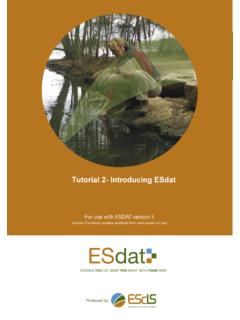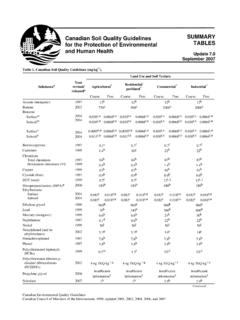Transcription of Table 5-A - Soil Investigation Levels (mg/kg) - ESdat
1 ESdat Environmental Database Management Software +61 2 9232 8080. Table 5-A - soil Investigation Levels (mg/kg). Ecological Substances Health Investigation Levels (HILs) Investigation Background Levels (EILs). Interim Ranges6. A1 B2 C3 D E F REIL4 Urban5. METALS/METALLOIDS. Arsenic (total) 100 400 200 500 20 1 - 50. Barium 300 100 - 3000. Beryllium 20 80 40 100. Cadmium 20 80 40 100 3 1. Chromium (III) 12% 48% 24% 60% 400. Chromium (VI) 100 400 200 500 1. Chromium (Total)*7 5 - 1000. Cobalt 100 400 200 500 1 - 40. Copper 1000 4000 2000 5000 100 2 - 100. Lead 300 1200 600 1500 600 2 - 200. Manganese 1500 6000 3000 7500 500 850. Methyl mercury 10 40 20 50. Mercury (inorganic) 15 60 30 75 1 Nickel 600 2400 600 3000 60 5 - 500.
2 Vanadium 50 20 - 500. Zinc 7000 28000 14000 35000 200 10 - 300. ORGANICS. Aldrin + Dieldrin 10 40 20 50. Chlordane 50 200 100 250. DDT + DDD + DDE 200 800 400 1000. Heptachlor 10 40 20 50. Polycyclic aromatic 20 80 40 100. hydrocarbons (PAHs). Benzo(a)pyrene 1 4 2 5. Phenol 8500 34000 17000 42500. PCBs (Total) 10 40 20 50. Petroleum Hydrocarbon Components (constituents): >C16 C35 90 360 180 450. Aromatics8. >C16 C35 5600 22400 11200 28000. Aliphatics >C35 Aliphatics 56000 224000 112000 280000. OTHER. Boron 3000 12000 6000 15000. Cyanides (Complexed) 500 2000 1000 2500. Cyanides (free) 250 1000 500 1250. Phosphorus 2000. Sulfur 600. Sulfate9 2000. 1 Human exposure settings based on land use have been established for HILs (see Taylor and Langley 1998).
3 These are: A. 'Standard' residential with garden/accessible soil (home-grown produce contributing less than 10% of vegetable and fruit intake; no poultry): this category includes children's day-care centres, kindergartens, preschools and primary schools. B. Residential with substantial vegetable garden (contributing 10% or more of vegetable and fruit intake) and/or poultry providing any egg or poultry meat dietary intake. C. Residential with substantial vegetable garden (contributing 10% or more of vegetable and fruit intake); poultry excluded. D. Residential with minimal opportunities for soil access: includes dwellings with fully and permanently paved yard space such as high-rise apartments and flats.
4 E. Parks, recreational open space and playing fields: includes secondary schools. F. Commercial/Industrial: includes premises such as shops and offices as well as factories and industrial sites. (For details on derivation of HILs for human exposure settings based on land use see Schedule B(7A). 2 Site and contaminant specific: on site sampling is the preferred approach for estimating poultry and plant uptake. Exposure estimates may then be compared to the relevant ADIs, PTWIs and GDs. 3 Site and contaminant specific: on site sampling is the preferred approach for estimating plant uptake.. Exposure estimates may then be compared to the relevant ADIs, PTWIs and GDs. 4 These will be developed for regional areas by jurisdictions as required.)
5 5 Interim EILs for the urban setting are based on considerations of phytotoxicity, ANZECC B Levels , and soil survey data from urban residential properties in four Australian capital cities. 6 Background ranges, where HILs or EILs are set, are taken from the Field Geologist's Manual, compiled by D A Berkman, Third Edition 1989. Publisher The Australasian Institute of Mining & Metallurgy. This publication contains information on a more extensive list of soil elements than is included in this Table . Another source of information is Contaminated Sites Monograph No. 4: Trace Element Concentrations in Soils from Rural & Urban Areas of Australia, 1995. South Australian Health Commission. 7 Valence state not distinguished expected as Cr (III).
6 8 The carbon number is an equivalent carbon number' based on a method that standardises according to boiling point. It is a method used by some analytical laboratories to report carbon numbers for chemicals evaluated on a boiling point GC column. 9 For protection of built structures. Schedule B (1) - Guideline on Investigation Levels for soil and Groundwater 9. ESdat Environmental Database Management Software +61 2 9232 8080. Table 5-B. Groundwater Investigation Levels Drinking SETTING10 Aquatic Ecosystems11 Agricultural9. Water Marine Fresh Health10/. Irrigation Livestock Waters Waters Aesthetic11. (mg/L) (mg/L). g/L g/L mg/L. METALS/METALLOIDS. Aluminium <5 (if pH < ) ( ) <100(if pH > ). Antimony 30 Arsenic (total) 50 Barium Beryllium 4 Boron Cadmium Chromium (Total) 10 Chromium (VI) Cobalt Copper ( ) Iron 1000 ( ) Lead Lithium Manganese ( ) Mercury (total) Molybdenum Nickel Selenium Silver Thallium Tin (tributyltin) Vanadium Zinc ( ) ORGANICS.
7 1,2-dichloroethane Benzo(a)pyrene Carbon tetrachloride Chlorobenzene ( ). Dichloromethane (methylene chloride) Ethylbenzene ( ). Ethylenediamine tetracetic acid (EDTA) Hexachlorobutadiene 10 Levels for recreational and industrial uses have not been set. For guidance on Recreational Levels , see NHMRC/ARMCANZ, 1996. For recreational uses, toxic substances should, in general, not exceed the concentrations given for drinking water. For guidance on Industrial Levels , see ANZECC, 1992. Industrial settings include: generic processes, hydro-electric power generation, textiles, chemical and allied industries, food and beverage, iron and steel, tanning and leather, pulp and paper, petroleum. 11 Taken from Australian Water Quality Guidelines for Fresh and Marine Waters (AWQG) (ANZECC 1992).
8 Schedule B (1) - Guideline on Investigation Levels for soil and Groundwater 10. ESdat Environmental Database Management Software +61 2 9232 8080. Drinking SETTING10 Aquatic Ecosystems11 Agricultural9. Water Marine Fresh Health10/. Irrigation Livestock Waters Waters Aesthetic11. (mg/L) (mg/L). g/L g/L mg/L. ORGANICS ( ). Monocyclic aromatic compounds Benzene Chlorinated benzenes Chlorinated phenols Phenol Toluene ( ). Xylene ( ). Pesticides Footnote14 Footnote15 Footnote16 See guidelines Aldrin ng/L ng/L for raw Chlordane ng/L ng/L water for DDT ng/L ng/L drinking water Dieldrin ng/L ng/L supply Heptachlor ng/L ng/L (AWQG, ANZECC. 1992). Phthalate esters di-n-butylphthalate di(2-ethylhexyl)phthalate other phthalate esters Polyaromatic hydrocarbons Polychlorinated biphenyls Polycyclic aromatic hydrocarbons Styrene (vinylbenzene) ( ).
9 Tetrachloroethene Trichlorobenzenes (total) ( ). Vinyl chloride OTHER. Calcium 1, Chloride ( ) Cyanide 5 Fluoride Nitrate-N Nitrite-N AESTHETIC PARAMETERS. Colour and clarity < 10% < 10%. change in change in euphotic euphotic depth depth 12 See Table , AWQG (ANZECC 1992) for further information 13 see Table , p2-50 AWQG (ANZECC 1992) for further information 14 see Table also, (ANZECC 1992) for further information 15 see Table also, (ANZECC 1992) for further information 16 see Table on p32 (Guidelines for Pesticides), p32 (NHMRC/ARMCANZ 1996). 17 Maximum chloride concentration should be set according to the sensitivity of the crop. For further information. (See Tables , , , , ANZECC 1992). Schedule B (1) - Guideline on Investigation Levels for soil and Groundwater 11.





